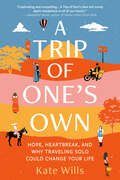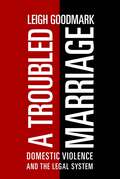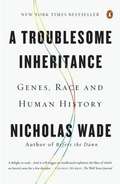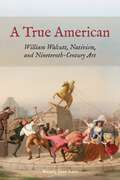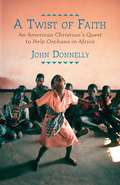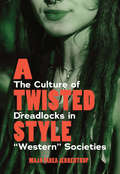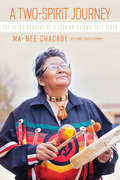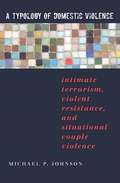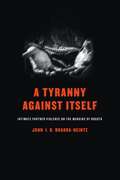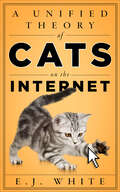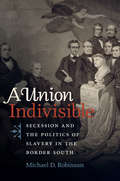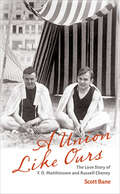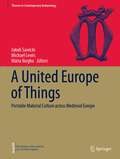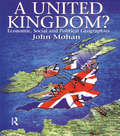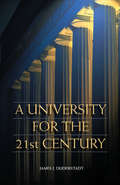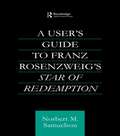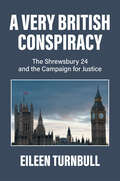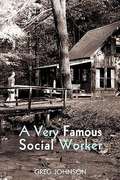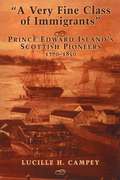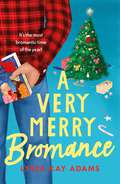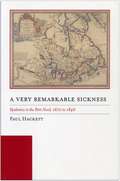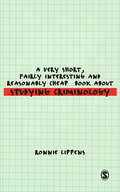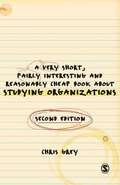- Table View
- List View
A Trip of One's Own: Hope, Heartbreak, and Why Traveling Solo Could Change Your Life
by Kate WillsAre you ready to embark on a life-altering adventure that will redefine your perspectives and open your heart to boundless possibilities? In this compelling memoir, travel writer Kate Wills fearlessly delves into her personal experiences, weaving a captivating narrative of hope, healing, and self-discovery. With courage as her compass, she embarks on solo expeditions across the globe, unearthing profound insights along the way.Follow Kate on her adventures through bustling cities, awe-inspiring landscapes, and tranquil retreats. Feel the rush of adrenaline as she embraces thrilling escapades, and share in her moments of vulnerability as she navigates through heartbreak and loneliness.A Trip of One's Own not only showcases the sheer joy of independent travel but also delves into the empowering and life-changing effects it can have. As you turn each page, you'll find yourself irresistibly drawn into Kate's world, feeling the warmth of new friendships and experiencing the freedom that only solo travel can offer. Embrace her triumphs, share her laughter, and learn from her challenges as you embark on this remarkable voyage together.A Trip of One's Own is not just a travel memoir; it's a profound testament to the transformative power of traversing the world on your own terms. Whether you're a seasoned traveler or a novice adventurer, this book will ignite your wanderlust and motivate you to chart your course towards self-discovery and personal growth.
A Troubled Marriage: Domestic Violence and the Legal System
by Leigh GoodmarkChoice's Outstanding Academic Title list for 2013The development of a legal regime to combat domestic violence in the United States has been lauded as one of the feminist movement’s greatest triumphs. But, Leigh Goodmark argues, the resulting system is deeply flawed in ways that prevent it from assisting many women subjected to abuse. The current legal response to domestic violence is excessively focused on physical violence; this narrow definition of abuse fails to provide protection from behaviors that are profoundly damaging, including psychological, economic, and reproductive abuse. The system uses mandatory policies that deny women subjected to abuse autonomy and agency, substituting the state’s priorities for women’s goals. A Troubled Marriage is a provocative exploration of how the legal system’s response to domestic violence developed, why that response is flawed, and what we should do to change it. Goodmark argues for an anti-essentialist system, which would define abuse and allocate power in a manner attentive to the experiences, goals, needs and priorities of individual women. Theoretically rich yet conversational, A Troubled Marriage imagines a legal system based on anti-essentialist principles and suggests ways to look beyond the system to help women find justice and economic stability, engage men in the struggle to end abuse, and develop community accountability for abuse.
A Troublesome Inheritance
by Nicholas WadeDrawing on startling new evidence from the mapping of the genome, an explosive new account of the genetic basis of race and its role in the human story Fewer ideas have been more toxic or harmful than the idea of the biological reality of race, and with it the idea that humans of different races are biologically different from one another. For this understandable reason, the idea has been banished from polite academic conversation. Arguing that race is more than just a social construct can get a scholar run out of town, or at least off campus, on a rail. Human evolution, the consensus view insists, ended in prehistory. Inconveniently, as Nicholas Wade argues in A Troublesome Inheritance, the consensus view cannot be right. And in fact, we know that populations have changed in the past few thousand years--to be lactose tolerant, for example, and to survive at high altitudes. Race is not a bright-line distinction; by definition it means that the more human populations are kept apart, the more they evolve their own distinct traits under the selective pressure known as Darwinian evolution. For many thousands of years, most human populations stayed where they were and grew distinct, not just in outward appearance but in deeper senses as well. Wade, the longtime journalist covering genetic advances for The New York Times, draws widely on the work of scientists who have made crucial breakthroughs in establishing the reality of recent human evolution. The most provocative claims in this book involve the genetic basis of human social habits. What we might call middle-class social traits--thrift, docility, nonviolence--have been slowly but surely inculcated genetically within agrarian societies, Wade argues. These "values" obviously had a strong cultural component, but Wade points to evidence that agrarian societies evolved away from hunter-gatherer societies in some crucial respects. Also controversial are his findings regarding the genetic basis of traits we associate with intelligence, such as literacy and numeracy, in certain ethnic populations, including the Chinese and Ashkenazi Jews. Wade believes deeply in the fundamental equality of all human peoples. He also believes that science is best served by pursuing the truth without fear, and if his mission to arrive at a coherent summa of what the new genetic science does and does not tell us about race and human history leads straight into a minefield, then so be it. This will not be the last word on the subject, but it will begin a powerful and overdue conversation.
A Troublesome Inheritance: Genes, Race and Human History
by Nicholas WadeDrawing on startling new evidence from the mapping of the genome, an explosive new account of the genetic basis of race and its role in the human story Fewer ideas have been more toxic or harmful than the idea of the biological reality of race, and with it the idea that humans of different races are biologically different from one another. For this understandable reason, the idea has been banished from polite academic conversation. Arguing that race is more than just a social construct can get a scholar run out of town, or at least off campus, on a rail. Human evolution, the consensus view insists, ended in prehistory.Inconveniently, as Nicholas Wade argues in A Troublesome Inheritance, the consensus view cannot be right. And in fact, we know that populations have changed in the past few thousand years--to be lactose tolerant, for example, and to survive at high altitudes. Race is not a bright-line distinction; by definition it means that the more human populations are kept apart, the more they evolve their own distinct traits under the selective pressure known as Darwinian evolution. For many thousands of years, most human populations stayed where they were and grew distinct, not just in outward appearance but in deeper senses as well.Wade, the longtime journalist covering genetic advances for The New York Times, draws widely on the work of scientists who have made crucial breakthroughs in establishing the reality of recent human evolution. The most provocative claims in this book involve the genetic basis of human social habits. What we might call middle-class social traits--thrift, docility, nonviolence--have been slowly but surely inculcated genetically within agrarian societies, Wade argues. These "values" obviously had a strong cultural component, but Wade points to evidence that agrarian societies evolved away from hunter-gatherer societies in some crucial respects. Also controversial are his findings regarding the genetic basis of traits we associate with intelligence, such as literacy and numeracy, in certain ethnic populations, including the Chinese and Ashkenazi Jews.Wade believes deeply in the fundamental equality of all human peoples. He also believes that science is best served by pursuing the truth without fear, and if his mission to arrive at a coherent summa of what the new genetic science does and does not tell us about race and human history leads straight into a minefield, then so be it. This will not be the last word on the subject, but it will begin a powerful and overdue conversation.From the Trade Paperback edition.
A True American: William Walcutt, Nativism, and Nineteenth-Century Art
by Wendy Jean KatzThis book argues that nativism, the hostility especially to Catholic immigrants that led to the organization of political parties like the Know-Nothings, affected the meaning of nineteenthcentury American art in ways that have gone unrecognized. In an era of industrialization, nativism’s erection of barriers to immigration appealed to artisans, a category that included most male artists at some stage in their careers. But as importantly, its patriotic message about the nature of the American republic also overlapped with widely shared convictions about the necessity of democratic reform. Movements directed toward improving the human condition, including anti-slavery and temperance, often consigned Catholicism, along with monarchies and slavery, to a repressive past, not the republican American future. To demonstrate the impact of this political effort by humanitarian reformers and nativists to define a Protestant character for the country, this book tracks the work and practice of artist William Walcutt. Though he is little known today, in his own time his efforts as a painter, illustrator and sculptor were acclaimed as masterly, and his art is worth reconsidering in its own right. But this book examines him as a case study of an artist whose economic and personal ties to artisanal print culture and cultural nationalists ensured that he was surrounded by and contributed to anti-Catholic publications and organizations. Walcutt was not anti immigrant himself, nor a member of a nativist party, but his kin, friends, and patrons publicly expressed warnings about Catholic and foreign political influence. And that has implications for better-known nineteenth-century historical and narrative art. Precisely because Walcutt’s profile and milieu were so typical for artists in this period, this book is able to demonstrate how central this supposedly fringe movement was to viewers and makers of American art.
A Twist of Faith: An American Christian's Quest to Help Orphans in Africa
by John DonnellyAmerican Christians, veteran reporter John Donnelly has discovered, are an ever-increasing source of aid in Africa, with some experts estimating that U. S. churches supply more resources to Africa than USAID. InA Twist of Faith, he tells the unlikely story of how faith and determination compelled one such American Christian to travel to Africa and open a school for children orphaned by the AIDS epidemic. David Nixon, a carpenter from North Carolina who had lived through his share of trouble, knew nothing about the small, land-locked African country of Malawi. But after having a religious awakening and hearing about a preacher's efforts to aid its impoverished and beleaguered citizens, he raises money from his church and sets off to do what so many well-intentioned Americans of faith do in Africa: build an orphanage. But as his plans are beset with difficulties, Nixon slowly comes to realize that helping others requires listening to and learning from them. And that means changing his preconceived ideas of what the Malawians need and how he can best serve them. A Twist of Faithis the story of one man who, despite personal struggles, a profound cultural gap, the corruption of local officials, and the heartbreak of losing an orphan he comes to love, saves himself by saving others in a place nothing like home. Nixon's story is representative of a growing trend: the thousands of American Christians who are impassioned donors of time, money, and personal energy, devoted to helping African children.
A Twisted Style: The Culture of Dreadlocks in “Western” Societies
by Maja Tabea JerrentrupIn "western" cultures, some people have chosen a dreadlock hairstyle, despite many in mainstream society looking at it in a negative light. This book deals with contradictions surrounding the hairstyle such as often representing a protest against the prevailing right-wing political systems, yet also emphasizing the white person’s power to appropriate any style. Based on interviews and close observations in social media, the book offers insights into the culture(s) surrounding dreadlocks and ultimately interprets the phenomenon as a postmodern form of individuality.
A Two-Spirit Journey: The Autobiography of a Lesbian Ojibwa-Cree Elder
by Ma-Nee ChacabyFrom her early, often harrowing memories of life and abuse in a remote Ojibwa community, Ma-Nee Chacaby's extraordinary story is one of enduring and ultimately overcoming the social and economic legacies of colonialism. As a child, Chacaby learned spiritual and cultural traditions from her Cree grandmother and trapping, hunting, and bush survival skills from her Ojibwa stepfather. She also suffered physical and sexual violence, and in her teen years became an alcoholic herself. At twenty, Chacaby took her children and, fleeing an abusive marriage, moved to Thunder Bay. Despite the abuse, racism, and indifference she often found there, Chacaby marshalled the strength and supports to help herself and others. Over the following decades, she achieved sobriety, trained and worked as an alcoholism counsellor, raised her children and fostered many others, learned to live with visual impairment, and came out as a lesbian. In 2013, Chacaby led the first gay pride parade in Thunder Bay. Ma-Nee Chacaby has emerged from hardship grounded in faith, compassion, and humour. Her memoir provides unprecedented insights into the challenges still faced by many Indigenous people.
A Typology of Domestic Violence: Intimate Terrorism, Violent Resistance, and Situational Couple Violence
by Michael P. JohnsonThis volume begins the work of theorizing forms of domestic violence, a crucial first step to a better understanding of these phenomena among scholars, social scientists, policy makers, and service providers.
A Tyranny Against Itself: Intimate Partner Violence on the Margins of Bogotá
by John I. Bhadra-HeintzUsme, one of the peripheral districts surrounding Bogotá, Colombia, is one of the poorest, most populous, and most marginalized outer districts of the city, with a high concentration of indigenous occupants. Over eighty percent of Usme’s women have experienced partner violence or some kind of partner-controlling behavior.How does one go about understanding the perpetration of partner violence? Based on ethnographic work with survivors, responders, and most of all the perpetrators of this kind of abuse, scholar John I.B. Bhadra-Heintz explores this issue in A Tyranny Against Itself. Throughout this study, Bhadra-Heintz examines how this violence is made possible, how it is positioned to be permissible socially, and what is at stake for those who are involved.This violence is examined as a question of sovereignty on the intimate scale. Not the product of a particular cultural pathology, a phenomenon that can otherwise be otherized, this book seeks instead to find the lines of connection, and contradiction, that tie these intimate acts of violence into broader regimes of power. In a community so profoundly shaped by centuries of political conflict, only through this kind of approach can new apertures for engagement be found. Through them, this book outlines new vulnerabilities in this form of abuse, and along the way imagines new ways of escaping from these everyday acts of intimate terror and the broader systems of violence in which they are involved.
A Unified Theory of Cats on the Internet
by E.J. WhiteHow cats became the undisputed mascot of the internet. The advertising slogan of the social news site Reddit is "Come for the cats. Stay for the empathy." Journalists and their readers seem to need no explanation for the line, "The internet is made of cats." Everyone understands the joke, but few know how it started. A Unified Theory of Cats on the Internet is the first book to explore the history of how the cat became the internet's best friend. Internet cats can differ in dramatic ways, from the goth cats of Twitter to the glamourpusses of Instagram to the giddy, nonsensical silliness of Nyan Cat. But they all share common traits and values. Bringing together fun anecdotes, thoughtful analyses, and hidden histories of the communities that built the internet, Elyse White shows how japonisme, punk culture, cute culture, and the battle among different communities for the soul of the internet informed the sensibility of online felines. Internet cats offer a playful—and useful—way to understand how culture shapes and is shaped by technology. Western culture has used cats for centuries as symbols of darkness, pathos, and alienation, and the communities that helped build the internet explicitly constructed themselves as outsiders, with snark and alienation at the core of their identity. Thus cats became the sine qua non of cultural literacy for the Extremely Online, not to mention an everyday medium of expression for the rest of us. Whatever direction the internet takes next, the "series of tubes" is likely to remain cat-shaped.
A Union Indivisible: Secession and the Politics of Slavery in the Border South (Civil War America)
by Michael D. RobinsonMany accounts of the secession crisis overlook the sharp political conflict that took place in the Border South states of Delaware, Kentucky, Maryland, and Missouri. Michael D. Robinson expands the scope of this crisis to show how the fate of the Border South, and with it the Union, desperately hung in the balance during the fateful months surrounding the clash at Fort Sumter. During this period, Border South politicians revealed the region's deep commitment to slavery, disputed whether or not to leave the Union, and schemed to win enough support to carry the day. Although these border states contained fewer enslaved people than the eleven states that seceded, white border Southerners chose to remain in the Union because they felt the decision best protected their peculiar institution. Robinson reveals anew how the choice for union was fraught with anguish and uncertainty, dividing families and producing years of bitter internecine violence. Letters, diaries, newspapers, and quantitative evidence illuminate how, in the absence of a compromise settlement, proslavery Unionists managed to defeat secession in the Border South.
A Union Like Ours: The Love Story of F. O. Matthiessen and Russell Cheney
by Scott Bane“An example of how two men could—precariously and passionately—live together and love each other in the America of the 1930s and 1940s.” —Colm Tóibín, New York Times-bestselling author of The MagicianAfter a chance meeting aboard the ocean liner Paris in 1924, Harvard University scholar and activist F. O. Matthiessen and artist Russell Cheney fell in love, and remained inseparable until Cheney’s death in 1945. During the intervening years, the men traveled throughout Europe and the United States, achieving great professional success while contending with serious personal challenges, including addiction, chronic disease, and severe depression.Situating the couple’s private correspondence alongside other sources, Scott Bane tells the remarkable story of their relationship in the context of shifting social dynamics in the United States. From the vantage point of the present day, with marriage equality enacted into law, Bane provides a window into the realities faced by same-sex couples in the early twentieth century, as they maintained relationships in the face of overt discrimination and the absence of legal protections.“A nuanced exploration of a marriage, one characterized by great joy but also buffeted by tremendous conflict (societal, financial, and health-related).” —R. Tripp Evans, author of Grant Wood: A Life“A smart, sensitive study of a gay couple…extremely readable.” —Gay & Lesbian Review“An arresting account of how a same-sex relationship endured.” —Library Journal
A United Europe of Things: Portable Material Culture across Medieval Europe (Themes in Contemporary Archaeology)
by Michael Lewis Jakub Sawicki Mária VarghaThis volume studies high and late medieval material culture in a Pan-European context. The idea of ‘unity of culture’ in Medieval Latin Europe is well known in historical texts, especially when it concerns the so-called ‘Europe North of the Alps’. This book investigates the similarities and differences in material culture between areas, regions and political entities and opens the dialogue for a more interregional discussion. The editors acknowledge that there are numerous challenges in understanding the phenomenon the volume addresses, the fundamental one being defining (or even redefining) a common material culture of Europe. Important in determining this is greater appreciation of how objects reflect interactions between peoples, both local and foreign, which can be driven by a variety of factors, including trade, conflict and diplomacy etc. But just as important is observing the differences between ‘things’ across Europe, reflecting developments and transformations its cultural, social and economic history. These works are traditionally presented in isolation or at the local level, maybe even in very specialized tomes, as often it is thought their observation are not relevant to wider discourses. Conversely, what is clear, however, is that by interconnecting these seemingly introvert studies of specific artefact types or sites etc., readers can better appreciate the similarities and differences in material culture across Europe. This book is of interest to researchers in archaeology and material culture.
A United Kingdom?: Economic, Social and Political Geographies
by John MohanThe human geography of the UK is currently being reshaped by a number of forces - such as globalisation, transition in the organisations of production, the changing character of state intervention, and changing relationships with Europe. A consideration of the impacts of these forces on economic, social and political landscapes is, therefore, an urgent task. At the same time, enduring institutional features of the British economy and polity are also having important influences on socio-economic processes. The result is a complex mosaic of uneven development, which belies the notion of simplistic regional contrasts.Rather than simply mapping spatial inequality, 'A United Kingdom?' charts the processes underpinning uneven development at a range of scales and for a number of key topics. The book draws upon and synthesises the latest contemporary research findings and places emphasis on the interrelated nature of economic, social and political geographies. It treats the human geographies of the UK in a coherent and integrated way, and asks whether contemporary processes of change are tending towards the reduction of socio-spatial divisions or their reproduction in new forms.
A University for the 21st Century
by James J. DuderstadtFrom the former president of one of America's leading universities comes a comprehensive analysis of the challenges and opportunities facing higher education in America as we enter the twenty-first century. InA University for the Twenty-first Century, James J. Duderstadt discusses the array of powerful economic, social, and technological forces that are driving the rapid and profound change in American social institutions and universities in particular. Change has always characterized the university as it has sought to preserve and propagate the intellectual achievements, the cultures, and the values of our civilization. However, the capacity of the university to change, through a process characterized by reflection, reaction, and consensus, simply may not be sufficient to allow the university to control its own destiny. Not only will social and technical change be a challenge to the American university, Duderstadt says, it will be the watchword for the years ahead. And with change will come unprecedented opportunities for those universities with the vision, the wisdom, and the courage to lead in the twenty-first century. The real question raised by this book is not whether higher education will be transformed, but ratherhow. . . and bywhom. James J. Duderstadt is President Emeritus and University Professor of Science and Engineering, University of Michigan.
A User's Guide to Franz Rosenzweig's Star of Redemption (Routledge Jewish Studies Series)
by Norbert M. SamuelsonThis user-friendly guide will help students of the 'Star' to be able to discuss at a basic level what, at least conceptually, Rosenzweig intended to say and how all that he says is interrelated.
A User's Guide to the Age of Tech (Electronic Mediations)
by Grant WythoffHow users experience and influence technological change—when so much of that change feels out of our control Every day, we casually employ one of the most complex tools ever created, using it to read the news, plan our day, and connect with friends. In A User&’s Guide to the Age of Tech, Grant Wythoff investigates the process by which now-ubiquitous technologies like our phones become integrated into our lives, showing how the &“gadget&” stage—before devices are widely adopted—opens the door for users to co-create these technologies and adapt them toward unexpected ends. In this elegant, approachable work, Wythoff offers a view of how users make new technology their own, subverting dominant power structures and imagining uses never intended by their creators. Rooted in a detailed look into the history of technique (focusing on how we do things with tools rather than the tools themselves), A User&’s Guide to the Age of Tech proceeds to complicate, and influence, discussion of subjects like the digital divide and AI. Drawing on a range of sources, including novels, patents, and newspapers, Wythoff explores the vernacular philosophies that have emerged from users and their diverse, everyday practices, bringing down to earth the conversation about digital titans, away from the abstracted domains of server farms and algorithms. Lodging a passionate argument that we know ourselves better than the data brokers who appear to wield influence over our psyches, Wythoff invites readers (and tech users) to imagine their own digital technique, acknowledge their vast expertise, and see its immense value. Retail e-book files for this title are screen-reader friendly with images accompanied by short alt text and/or extended descriptions.
A Very British Conspiracy: The Shrewsbury 24 and the Campaign for Justice
by Eileen TurnbullThe story of the campaign for justice for the 24 building workers wrongly prosecuted by the state in the 1970sWhen a group of North Wales building workers were put on trial for picketing-related offences during the first and only national building workers strike in Britain, it not only had a profound and lifelong impact upon them and their families. It also was a turning point for halting the growth of trade unionism in the building industry, from which it has never recovered.Using newly available material that Eileen Turnbull discovered in various archives whilst searching for the fresh evidence that would get the pickets convictions referred to the Court of Appeal, A British Conspiracy uncovers government and police documents that show the careful planning of the prosecution of the North Wales building workers. It brings into focus the secrecy surrounding the actions of the police and the government in the five months between the end of the strike in September 1972 and the arrest of the pickets on the 14 February 1973. It shows how the state used the criminal justice system to halt effective picketing by workers during industrial disputes. It reveals that common law offences were carefully selected to overcome the prosecutions&’ problems of a lack of hard evidence.The premature death of one of the convicted pickets was a catalyst for a group of trade unionists in the North West to come together in 2006 to organise a campaign. In February 2021, their appeal against the convictions was finally successful. The book describes, through their own words, how the pickets and their families felt after forty-seven years being ostracised and considered as criminals in their communities, as well as the response of the six core Campaign Committee members who had brought this historic victory about.
A Very Famous Social Worker
by Greg JohnsonWhen Greg Johnson was interviewing for a job at a mental health center his interview was interrupted by a police officer with a naked woman in tow. "I was looking for an adventure," he says, "and this looked like it." In A Very Famous Social Worker, the author recounts with insight and humor his experiences as a rookie social worker in West Virginia's Greenbrier Valley. His unlikely parade of clients include a preacher whose wildly rebellious children are threatening to bring down his ministry, a teenage underwear fetishist, a man obsessed with Dolly Parton, and a schizophrenic poet. He goes the extra mile, often literally, teaching a client to drive, transporting an inebriated musician to rehab, and navigating a winding country road with a three-tiered wedding cake. Engaging and entertaining, A Very Famous Social Worker sheds light on a profession practiced by 600,000 Americans that remains little known to the general public.
A Very Fine Class of Immigrants: Prince Edward Island's Scottish Pioneers, 1770-1850
by Lucille H. CampeyScots who opted for pioneer life in Prince Edward Island are the subject of this book. Being the first of the "northern" colonies to be sold off in its entirety to proprietors in the late eighteenth century, P.E.I. acquired its Scots earliest, doing so even before the start of the American War of Independence in 1775. The colonization of Prince Edward Island by Scots takes us back to a period when the process of emigration and settlement were in their infancy. The Pioneer Scots of Prince Edward Island should command our respect. They showed tremendous courage and determination and most were successful. Previous studies of early Scottish emigration to the New World have tended to concentrate on the miseries of evictions and the destruction of old communities. In this groundbreaking study of the influx of Scots to Prince Edward Island, the widely held assumption that emigration was solely a flight from poverty is challenged. By uncovering previously unreported ship crossings, as well as a wide range of manuscripts and underused sources such as customs records and newspaper shipping reports, the book provides the most comprehensive account to date of the influx of Scots to the Island. "A Very Fine Class of Immigrants" is essential reading for individuals wishing to trace family links or deepen their understanding of how and why the Island came to acquire its distinctive Scottish communities. And by accessing, for the first time, shipping sources like Lloyd’s List and the Lloyd’s Shipping Register, the author brings a new dimension to our understanding of emigrant travel. Lucille H. Campey demonstrates that far from sailing on disease-ridden leaky tubs, as popularly imagined, the Island’s Pioneer Scots usually crossed the Atlantic on the best available ships of the time.
A Very Merry Bromance: It's the most Bromantic time of the year! (Bromance Book Club #5)
by Lyssa Kay AdamsIf you love Ali Hazelwood, Sally Thorne and Helen Hoang, you'll LOVE Lyssa Kay Adams!'The most inventive, refreshing concept in rom-coms!' Entertainment Weekly The Bromance Book Club was one of Bustle's '21 Rom-Coms To Give You Warm And Fuzzy Feelings All Season Long'!Raves for The Bromance Book Club:'A you're-gonna-burn-dinner book because you will not want to put it down. Laugh out loud with tons of heart, this is an absolutely adorable must read' AVERY FLYNN'A delight! . . . I raced to finish this book, but still never wanted it to end!' ALEXA MARTIN'A delightful, fast-paced read with the perfect mix of laugh-out-loud and swoony moments - every town should have a Bromance Book Club' EVIE DUNMORE'It is the reading aloud in this story that ultimately wins my heart, and shows that everything worth knowing can be learned from romance' KC DYER.......................................'Tis the season to take out the mistletoe - and for a second chance at love.Country music's golden boy Colton Wheeler felt the most perfect harmony when he was with Gretchen Winthrop. But for her, it was a love-him-and-leave-him situation. A year later, Colton is struggling to make music, with only the Bromance Book Club standing between him and self-pity. It's hard for immigration attorney Gretchen not to feel a little Scrooge-ish about the excess of Christmas when her clients are scrambling to pay rent. So when her estranged, wealthy family makes her an offer that could help, she can't say no. She just needs to convince Colton to be the new face of their whiskey brand. No big deal . . .Colton agrees to consider Gretchen's offer in exchange for three dates before Christmas. With the help of the Bromance Book Club, he's determined to prove there's still a spark between them. But can Gretchen and Colton overcome the ghosts of Christmas past to build a future together?.......................................Readers are LOVING the Bromance Book Club series!'Five stars for this sweet, sexy, funny read''Wow! What to say about this book? It was everything and more . . . I loved absolutely everything about this book' 'Sweet and heartfelt and lovely. Vlad is just an absolute love and I could read about him being in love in every book!''This book was the full package. Amazing plot, great characters, sexual chemistry, heart, humour, vulnerability . . . A masterclass on romance novel construction' 'Heartfelt, sweet, emotional and tender . . . I can't get enough of this group of friends and I can't wait for the next addition!''I adored this book so much and flew through it so fast because I was loving it so much. I found myself laughing out loud multiple times . . . I just loved being back in this world with these characters so much!''Perfect for the summer holidays. An absolute feel-good romance with plenty of heart, laugh-out-loud scenes, and vulnerable yet strong characters. I couldn't put this book down'Don't miss any of the charming and swoonworthy Bromance Book Club reads!The Bromance Book ClubUndercover BromanceCrazy Stupid BromanceIsn't It Bromantic?A Very Merry Bromance
A Very Remarkable Sickness: Epidemics in the Petit Nord, 1670 to 1846 (Manitoba Studies in Native History #14)
by Paul HackettThe area between the Great Lakes and Lake Winnipeg, bounded on the north by the Hudson Bay lowlands, is sometimes known as the "Petit Nord." Providing a link between the cities of eastern Canada and the western interior, the Petit Nord was a critical communication and transportation hub for the North American fur trade for over 200 years.Although new diseases had first arrived in the New World in the 16th century, by the end of the 17th century shorter transoceanic travel time meant that a far greater number of diseases survived the journey from Europe and were still able to infect new communities. These acute, directly transmitted infectious diseases – including smallpox, influenza, and measles – would be responsible for a monumental loss of life and would forever transform North American Aboriginal communities.Historical geographer Paul Hackett meticulously traces the diffusion of these diseases from Europe through central Canada to the West. Significant trading gatherings at Sault Ste. Marie, the trade carried throughout the Petit Nord by Hudson Bay Company ships, and the travel nexus at the Red River Settlement, all provided prime breeding ground for the introduction, incubation and transmission of acute disease. Hackettís analysis of evidence in fur-trade journals and oral history, combined with his study of the diffusion behaviour and characteristics of specific diseases, yields a comprehensive picture of where, when, and how the staggering impact of these epidemics was felt.
A Very Short, Fairly Interesting and Reasonably Cheap Book About Studying Criminology (Very Short, Fairly Interesting & Cheap Books)
by Dr Ronnie LippensThis is the book that criminology students have been waiting for. Written in a lively and conversational style, it introduces and familiarizes students with a set of basic notions which are essential to the study of crime and its control. The book explains the background to the ideas that underpin current debates about crime. It explores the interplay between philosophical and criminological theories to provide a stimulating and insightful overview of the subject. It offers students a fresh way of thinking about crime, giving them an opportunity to develop their understanding and to hone their critical skills. The antidote to the boring textbook, this is the perfect accompaniment to any course on criminology.
A Very Short, Fairly Interesting and Reasonably Cheap Book About Studying Organizations (2nd Edition)
by Christopher John GreyRelevant across a range of management courses, the Second Edition of A Very Short Fairly Interesting and Reasonably Cheap Book About Studying Organizations offers students a lively, focused, and challenging discussion of classical and current ideas about organizations and their management. Building on the hugely popular First Edition, a new chapter explores the relationship between society and the economy, and the preoccupation with speed as it exists today.
